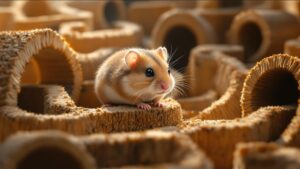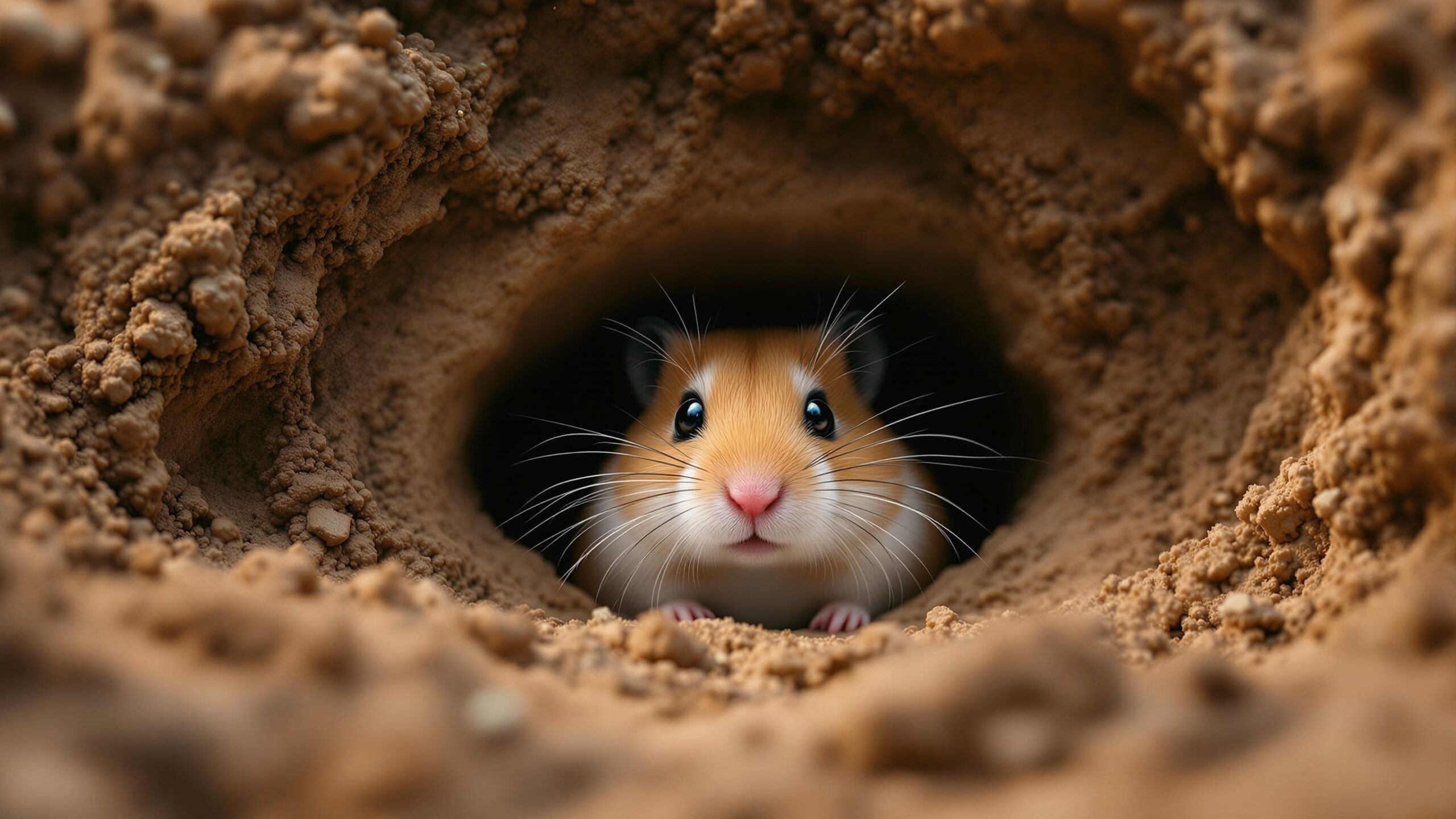Hamsters: Tiny Titans of the Rodent World
With twitching whiskers, ever-spinning wheels, and cheeks that can puff up like balloons, hamsters may seem like miniature entertainers of the animal kingdom. But these tiny mammals are far more than just adorable companions or classroom pets. Hamsters, belonging to the subfamily Cricetinae, are highly specialized rodents with unique adaptations, complex behaviors, and remarkable ecological roles. While they are familiar in homes across the world, their wild relatives are resilient survivors shaped by harsh deserts, mountain valleys, and temperate grasslands.
From solitary Syrian hamsters burrowing beneath Syrian fields to dwarf species darting across Central Asian steppes, this diverse group of small mammals showcases a surprising range of lifestyles, habitats, and evolutionary strategies. Hamsters represent a fascinating segment of the rodent family tree, one that blends charm with scientific significance.
In this comprehensive guide to the world of hamsters, we’ll uncover their biological foundations, explore their key types, and gain new appreciation for how these creatures live, survive, and—yes—stuff their faces with incredible efficiency.
A Closer Look: What Makes a Hamster a Hamster?
Hamsters are members of the subfamily Cricetinae, within the family Cricetidae, which also includes voles, lemmings, and New World rats and mice. There are currently 18 recognized species of hamsters, grouped into several genera. Though they vary in size and habitat, they share a set of common biological traits that define them.
Perhaps most iconic are their cheek pouches—elastic, fur-lined cavities on each side of the head that extend back to the shoulders. These pouches allow hamsters to carry food, bedding, or even their young when necessary. In the wild, this adaptation helps them gather food quickly in exposed environments before returning to the safety of their burrows.
Hamsters have stout bodies, short legs, and small, rounded ears. Most are nocturnal or crepuscular, meaning they are active during the night or twilight hours. Their eyesight is generally poor, but they compensate with an acute sense of smell and hearing. Many species are solitary and territorial, especially the larger kinds, while some of the smaller varieties are more tolerant of social interaction.
Their natural habitats span dry deserts, scrublands, alpine meadows, and agricultural regions. In the wild, hamsters are proficient diggers, constructing intricate burrow systems that offer protection from predators and extreme temperatures. Their diets are omnivorous and highly adaptable, including seeds, roots, insects, fruits, and vegetation.
These characteristics make hamsters not only adorable but also highly efficient survivors. Understanding the various types of hamsters allows us to appreciate their full diversity and significance beyond the pet store cage.

Campbell’s Dwarf Hamster
Campbell’s Dwarf Hamster: The Tiny Trailblazer of the Steppe Small in stature but brimming with character, Campbell’s Dwarf Hamster (Phodopus campbelli) is a spirited and fascinating species that has steadily carved out a place for itself in both the wild steppes of Central Asia and the hearts of pet enthusiasts around the globe. Often mistaken for its cousin, the Winter White Dwarf Hamster, Campbell’s Dwarf Hamster has its own distinct

Chinese Hamster
The Chinese Hamster: A Tiny Acrobat with a Big Personality Meet the Chinese Hamster (Cricetulus griseus), a small, agile rodent that might be modest in size but is rich in charm, character, and scientific interest. Often overshadowed by its more famous hamster cousins like the Syrian and the Roborovski, the Chinese Hamster is a fascinating species in its own right. With its silky fur, distinctive tail, and quick, inquisitive nature,

Roborovski Dwarf Hamster
The Roborovski Dwarf Hamster: A Tiny Dynamo of the Desert Among the smallest and most energetic mammals in the rodent world, the Roborovski Dwarf Hamster (Phodopus roborovskii) is a tiny creature that has captured the fascination of pet owners, scientists, and wildlife enthusiasts alike. Native to the vast deserts and dry steppes of Central Asia, this lightning-fast hamster has a big personality packed into a miniature frame. Its remarkable speed,

Syrian Hamster
A Tiny Titan of the Desert The Syrian Hamster (Mesocricetus auratus) is perhaps one of the most iconic and beloved small mammals in the world. Known by many names—Golden Hamster, Teddy Bear Hamster, and simply “hamster” in pet stores—this pint-sized rodent has captured the hearts of pet lovers across generations. But beyond the cages and colorful toys of domestic life lies a fascinating creature of resilience, adaptability, and surprising complexity.

Winter White Dwarf Hamster
The Arctic Wonder of the Rodent World Hidden beneath the snow-covered soils of Central Asia lives one of nature’s most charming and resilient small mammals—the Winter White Dwarf Hamster (Phodopus sungorus). This tiny rodent, famous for its seasonal white fur and compact, rounded physique, is a beloved pet around the globe and a remarkable example of adaptation in the wild. With origins in the harsh climates of Siberia, Kazakhstan, and
Syrian Hamsters: The Golden Soloists
The Syrian hamster, also known as the golden hamster (Mesocricetus auratus), is the most popular and widely recognized hamster species. Native to the arid lands of northern Syria and southern Turkey, it was first scientifically described in 1839 but wasn’t successfully bred in captivity until the 1930s. Today, virtually all domestic Syrian hamsters descend from a small number of wild individuals originally captured for research.
Syrian hamsters are relatively large compared to their cousins, growing up to seven inches in length. Their golden-brown coat, white underbelly, and inquisitive eyes have made them favorites in the pet world. But their fame extends beyond appearance. These hamsters are solitary to a fault—placing two adults in the same enclosure can result in serious aggression.
In the wild, Syrian hamsters lead secretive lives, emerging at dusk to forage. They carry food in their cheeks back to underground chambers, some of which can be more than three feet deep. These tunnels feature storage rooms, nesting areas, and latrines—a testament to their instinctive engineering.
Their importance in laboratory research is also notable. Syrian hamsters have been used in studies related to circadian rhythms, thermoregulation, and even infectious disease models. Their biology provides insights into human health while reinforcing their role as more than just pets.
Dwarf Hamsters: The Tiny Socialites
Unlike their solitary Syrian relatives, dwarf hamsters often exhibit more social tolerance, especially when raised together from a young age. This category encompasses several species, primarily within the genera Phodopus and Cricetulus, and includes popular pets like the Campbell’s dwarf hamster, winter white dwarf hamster, and the Roborovski dwarf hamster.
Campbell’s dwarf hamster (Phodopus campbelli) originates from the grassy steppes of Central Asia, thriving in Mongolia, northern China, and parts of Russia. It’s known for its thick fur, adaptability to cold environments, and playful demeanor. Its close cousin, the winter white dwarf hamster (Phodopus sungorus), also hails from Siberian regions and is famed for changing coat color—from brown-gray to white—in response to seasonal daylight changes.
The Roborovski hamster (Phodopus roborovskii) holds the title for the smallest and fastest of the group. Native to the deserts of Mongolia and northern China, these hamsters are hyperactive and curious but often too quick and timid to be handled frequently. Their speed and agility are evolutionary adaptations to avoid predators in open terrain.
Dwarf hamsters typically have shorter lifespans and weigh less than 50 grams, yet they’re full of personality. In the wild, they create relatively shallow but spacious burrows, and in captivity, they require tunnels, wheels, and plenty of hiding spots to mimic natural behaviors.
Their social nature, combined with smaller size, makes them popular choices for hamster enthusiasts who enjoy observing group dynamics, although even dwarf hamsters can become territorial if overcrowded.
European Hamsters: The Giant Underground Architects
The European hamster (Cricetus cricetus) is a species few people know well, despite its impressive size and fascinating behavior. Sometimes called the common hamster, this native of Central and Eastern Europe can grow up to 13 inches long—nearly twice the size of a Syrian hamster.
With a distinctive tri-colored coat—black belly, white limbs, and reddish-brown back—the European hamster is one of the most striking in appearance. Unlike many of its smaller relatives, it hibernates during winter months, often building elaborate burrows with separate chambers for food, nesting, and waste. Its cheek pouches are large enough to transport entire food reserves in a single foraging trip.
Despite its robust nature, the European hamster has seen dramatic population declines in recent decades due to habitat fragmentation, modern agriculture, and urbanization. Once considered an agricultural pest, it is now protected in many countries and has become a flagship species for conservation programs focused on European farmland biodiversity.
Though less commonly seen in captivity, the European hamster is a vital member of its ecosystem. It preys on insects and occasionally small vertebrates, serves as food for raptors and foxes, and plays a key role in soil aeration through its burrowing.
Its story reminds us that even species once dismissed as nuisances can prove ecologically essential and biologically fascinating.
Chinese Hamsters: The Quiet Climbers
The Chinese hamster (Cricetulus griseus) occupies a unique spot in the hamster world. Native to northern China and Mongolia, this species is not technically a dwarf hamster but shares a similar size. What sets it apart is its long, slender body and partially prehensile tail, allowing it to climb better than other hamster types.
Chinese hamsters are less common as pets but are favored in scientific research, particularly in genetics and biotechnology. In fact, a cell line derived from the Chinese hamster ovary—known as CHO cells—is widely used in medical and pharmaceutical development, including the production of vaccines and biologics.
In the wild, Chinese hamsters inhabit rocky and scrubby areas, often living in burrows among rocks or under tree roots. Their behavior is cautious and deliberate, with a strong preference for nighttime activity. They can be territorial and are best housed alone, although they are generally docile with humans when socialized early.
Their evolutionary niche as climbers and their contribution to science make them a valuable yet understated branch of the hamster family tree.
Wild Hamsters: The Undomesticated Majority
Though the hamsters seen in homes and labs are relatively few in species, most hamsters remain wild animals living far from human care. These include species like the Romanian hamster (Mesocricetus newtoni), Turkish hamster (Mesocricetus brandti), and various desert hamsters found in Central Asia and the Middle East.
These wild species tend to be elusive, nocturnal, and adapted to harsh environmental conditions. Their fur coats vary in density, color, and seasonal thickness to match the demands of their native regions. Many dig elaborate burrow systems, some of which are lined with grass and feathers to insulate nests against the cold.
Although little-studied compared to their domesticated cousins, wild hamsters offer valuable insights into rodent evolution, adaptation, and ecosystem roles. Their seed-storing behavior helps shape plant distribution, and they serve as prey for foxes, owls, and snakes.
As agricultural practices expand and wildlands shrink, some wild hamster populations have declined, prompting conservation monitoring in select areas. Understanding and protecting these lesser-known species adds depth to our view of what hamsters are and why they matter.
Hamsters and Humans: A Global Relationship
The relationship between hamsters and humans has evolved from discovery to utility to companionship. While their scientific contributions cannot be overstated, their popularity as pets has also flourished. Hamsters are now among the most common small pets in North America, Europe, and parts of Asia, valued for their manageable size, low maintenance, and charming behavior.
Yet with popularity comes responsibility. Many pet hamsters suffer from inadequate care due to misunderstanding their needs. Proper habitat size, enrichment, and diet are essential for a hamster’s health and happiness. Learning about their natural behaviors—such as burrowing, foraging, and nesting—can help pet owners provide better lives for their tiny companions.
In many cultures, hamsters symbolize resourcefulness and quiet determination. Their ability to endure in challenging environments, store food for lean times, and navigate the world through smell and memory echoes broader themes of survival and intelligence.
Whether found in a glass tank in a child’s bedroom, a laboratory bench, or a sun-baked field in Syria, the hamster’s presence is deeply felt and widely appreciated.
The Hidden World Beneath the Bedding
Beneath the surface of what appears to be a simple rodent lies a rich tapestry of behaviors, adaptations, and evolutionary brilliance. Hamsters are engineers, foragers, travelers, and survivors. Each sub-category—from the golden Syrian to the nimble Roborovski, from the massive European to the climbing Chinese—adds a unique note to the symphony of this often-overlooked animal group.
Their diversity is not just interesting—it’s essential. Each species tells a different story of geography, evolution, and survival. Together, they offer a fuller understanding of rodent life, and of the interwoven systems that support life across continents and climates.
Hamsters are small, yes—but their ecological impact, scientific value, and enduring relationship with humans make them giants in the grand mosaic of the natural world.
Dig Deeper into the Burrows of Discovery
This guide is just the beginning. Within the world of hamsters lies a deeper universe of stories waiting to be explored. Each species—wild or tame, rare or common—has its own tale of habitat, behavior, and adaptation.
Whether you’re captivated by the solitary golden hamster, intrigued by the social quirks of dwarf species, or amazed by the Chinese hamster’s role in medicine, there’s always more to learn. Dive into individual sub-category pages to uncover how each type contributes to science, ecosystems, and our shared history.
The next time you see a hamster disappear into its bedding or pause to sniff the air, consider the ancient instincts and evolutionary marvels at work behind those small, curious eyes. It’s a big world—even for the smallest mammals.

